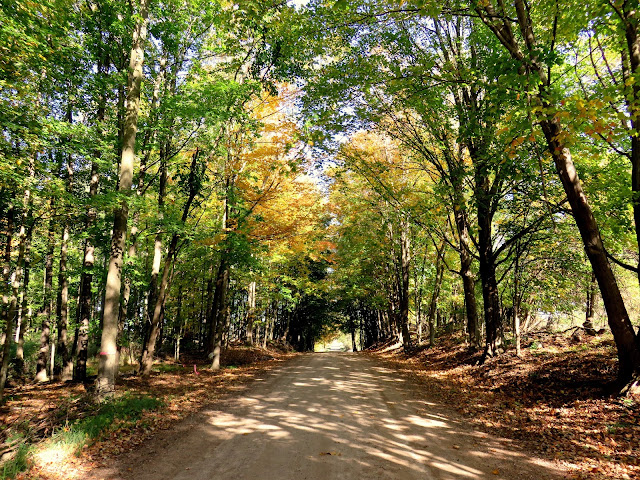Hardwoods, late in changing color this warm fall, arch over the dirt road, providing patches of shade to contrast the areas where the fields leave no room to rest in the shadow.
We are on a quest for the home of my great grandfather, Henry Leatherman, who owned 100 acres in this area of Campbell Township, Ionia County, in the 1870s and 1880s. (The 1900s are still a mystery.) He met his bride, Angeline Bentler, here in Michigan, perhaps at Bowne Church, in 1886 when she moved from Berlin (Kitchener) Ontario to Michigan with her father, Herman Bentler and his second wife, Catherine Schmitt, who had raised Angeline from the age of five.
The handsome young Mennonite farmer with a significant portion of land, 100 acres, was certainly a good catch for Angeline and by mid-1867, they were married and living on the land on a bluff overlooking Duck Creek in the northwest corner of his property.
On this gorgeous day in 2017, I journeyed west with fifth cousin Barb Swartz to see if we could find Henry's home or at least the property. We knew it was in Campbell township and Barb had found a map on a site that featured historical maps of Michigan that indicated who owned which plots in various townships, including Campbell, during a given year. Over 100 years later, the map was still spot-on.
This house is probably not his. Perhaps it was built on the bones of the original home and certainly is on the original site, but it is clearly a newer, more remodeled home. It sits on a hill just a few yards south of the creek.
One can easily imagine young John Philip and his brothers fishing in the creek, perhaps taking a well-deserved dip after a hot day working in the fields. You can almost hear his mother or his older sisters calling for supper and knew when you saw them they would be in their plain dresses with a pinafore apron and lace cap covering their hair.
Leaving the Leatherman property and heading north for several miles, we come to a large road (now 76th Street) and after taking a left-hand turn and venturing west over the county line into Kent County's Bowne Township, the Bowne Mennonite Cemetery and church is spotted. This is our next stop.
We are looking for the grave of Angeline who died of consumption (lung illness, possibly or even probably tuberculosis) on a warm July day in 1884. She left behind her husband, two teenaged boys and four children under the age of 12, one of whom was only a few months old.
We're also looking for the gravesite of her father, Herman Bentler, one of the earliest settlers in the county. We know both graves are there with headstones after a search on findagrave.com. We also know that Orvin and Henry's bodies were released to this cemetery, though no obvious grave was indicated.
Herman's grave is the first to be found, standing tall, a dignified obelisk marking his death and that of Catherine Schmitt, his wife. Barb has prepared cedar wreaths and we leave one behind for this man from Saxony in Germany who emigrated first to America (living in Buffalo, NY, for two years), then to Canada, where he married Lydia Bricker Kraft (or Croft) and fathered Angeline and her brother who died in infancy.
Angeline's grave, perhaps one of the earlier ones in the cemetery, is nearest the road in what one can imagine, based on the tombstones, to be the oldest area of the cemetery. Though the headstone was once standing, it is now flat and embedded in the ground, face up.
We trim some of the grass from the edges and leave behind a wreath for her as well. There are empty spaces beside her with no indication of burial. Might these be unmarked graves for Henry, who died in 1913 or little Orvin, who died at the age of 10 in 1894.
We will probably never know. What we do know is that it is a profoundly quiet and peaceful spot. We can imagine Henry and his children standing beside Angeline's grave at her funeral, dressed in their best on a hot summer day.
Henry's life, after Angeline's death and the subsequent death of two of his children, ten years later, just days apart, turned into one of tragedy. But as Barb and I sat under a sugar maple, enjoying an apple and grapes on this warm day, we could only think of the peace, quiet and beauty that was part of this quiet, gentle world, little changed in so many ways from the days 125 years before.
And I was profoundly grateful.













Learning about those who had a hand in shaping who we are now is great journey.
ReplyDeleteYour blog is truly breathtaking! Thanks for sharing this beautiful post with us. Explore the unique Space club disposables
ReplyDeleteMoon sugar disposables. offer a clean, powerful, and exciting experience.
Each flavor is a meticulously crafted blend of taste and sensation, coming together to give you a truly out-of-this-world experience.
Moon sugar disposables are ideal for anyone wanting to dive into a delicious and blissful journey packed with a powerful mix of cannabinoids, amazing flavors, and the convenience of a disposable thc vape. They provide a unique way to relax and enjoy a cosmic experience in any part of USA.
Space club carts.
Space club vape.
Space club lemon haze.
Space club wholesale.
Space club carts in USA.